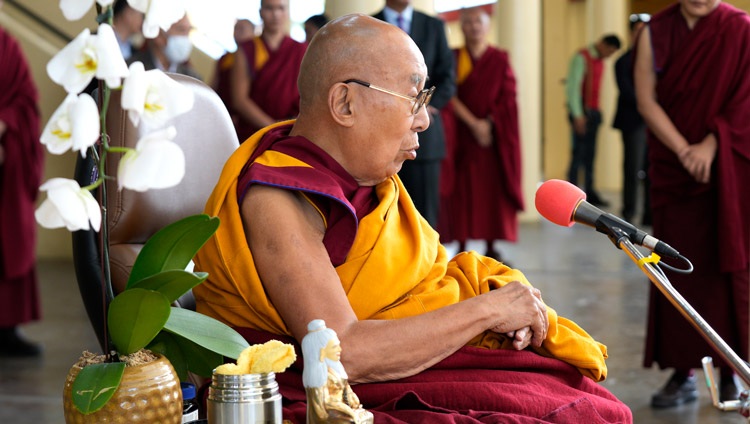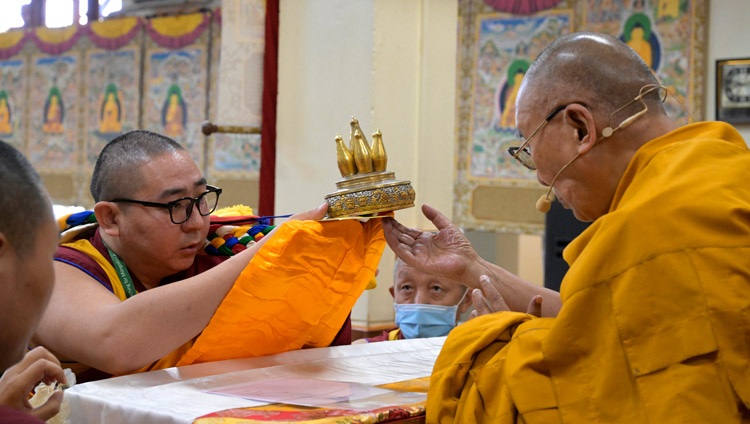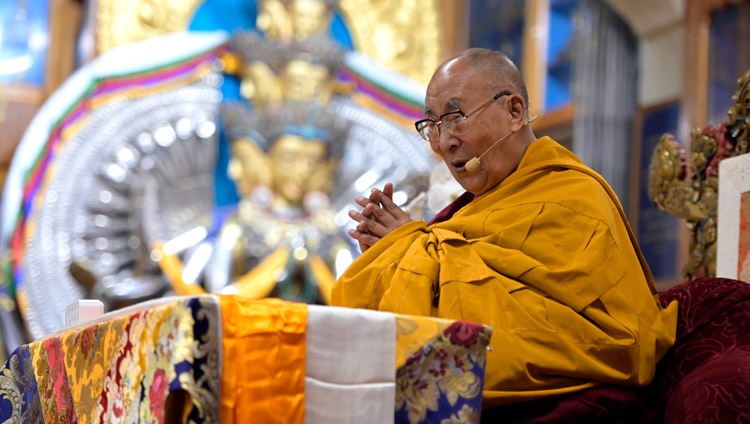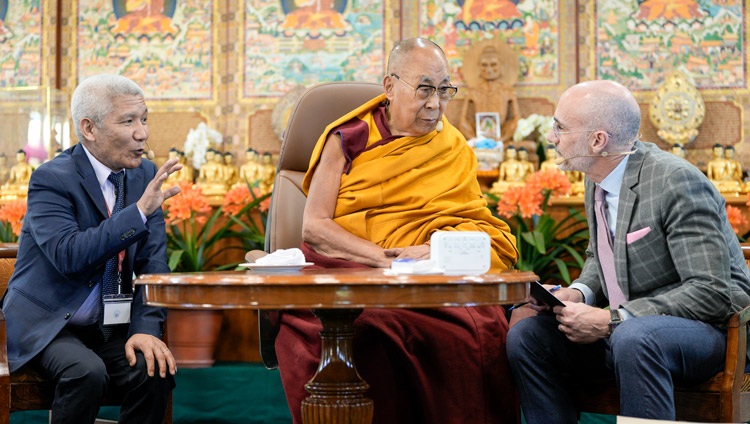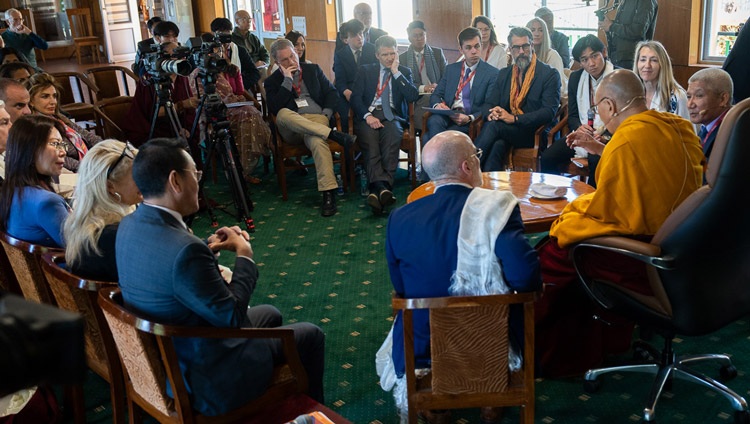Recognizing My Mother – An Experiential Song on the View
February 8, 2021
Thekchen Chöling, Dharamsala, HP, India – After Zopa Rinpoché in Kathmandu had formally welcomed him online this morning, His Holiness the Dalai Lama announced that Rinpoché had requested him to teach ‘Recognizing My Mother – An Experiential Song on the View’ and he had happily agreed to do so.
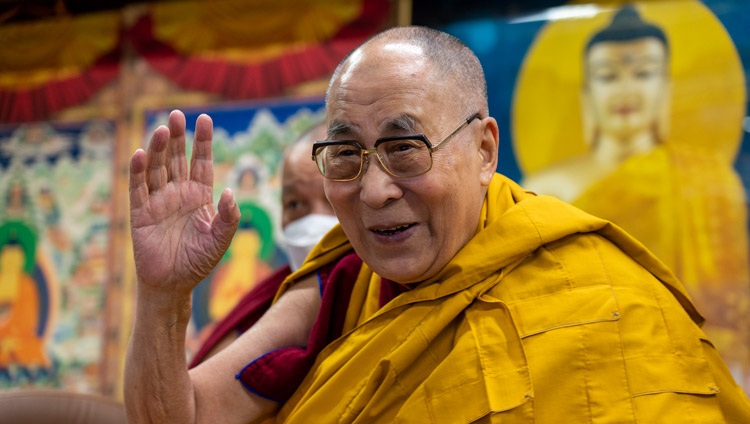
“First of all, the view referred to here is dependent arising. I often mention that while our view is dependent arising, our conduct is not to harm others. Both these ideas have a bearing on peace in the world. Regarding the authenticity of the Buddha’s teachings, shortly after his enlightenment the Buddha is said to have reflected:
Profound and peaceful, free from complexity, uncompounded luminosity-
I have found a nectar-like Dharma.
Yet if I were to teach it, no-one would understand,
So I shall remain silent here in the forest.
“We can understand the words, ‘profound and peaceful’ to refer to the first round of his instructions in which he revealed the four noble truths. ‘Free from complexity’ indicates the perfection of wisdom of the second round. ‘Uncompounded luminosity’ relates to the content of the third round of teachings, especially Buddha nature and the ‘Tathagatagarbha-sutra’.
“In the first round of his teachings the Buddha referred to true suffering, true origin, true cessation and the true path. In terms of their nature, he declared that suffering is to be known, the origin is to be eliminated, and cessation is to be actualized by cultivating the path. The origin to be eliminated is karma and mental afflictions. In order to discover whether true cessation can be attained, we have to examine whether suffering can be overcome.”
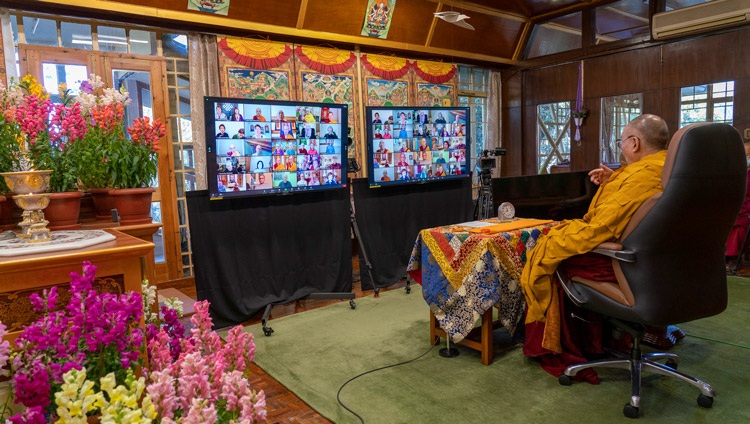
In this connection, His Holiness quoted a verse towards the end of the sixth chapter of ‘Entering into the Middle Way’.
Thus, illuminated by the rays of wisdom’s light,
the bodhisattva sees as clearly as a gooseberry on his open palm
that the three realms in their entirety are unborn from the very start,
and through the force of conventional truth, he journeys to cessation. 6.224
Then he added a verse from Aryadeva’s ‘400 Verses’
As the tactile sense [pervades] the body
Ignorance is present in all [mental afflictions].
By overcoming ignorance, you will also
Overcome all mental afflictions.
He remarked that ignorance can be overcome by understanding dependent arising. Chandrakirti alludes further to the bodhisattva.
Though his mind may rest continuously in cessation,
he generates compassion for beings bereft of protection.
Advancing further, he will also outshine through his wisdom
all those born from the Buddha’s speech and the middle buddhas. 6.225
At the opening of ‘Entering into the Middle Way’ Chandrakirti praises compassion and the awakening mind:
Buddhas are born from bodhisattvas.
The compassionate mind and nondual cognition
as well the awakening mind: these are causes of bodhisattvas. 1.1
As compassion alone is accepted to be
the seed of the perfect harvest of Buddhahood,
the water that nourishes it, and the fruit that is long a source of enjoyment,
I will praise compassion at the start of all. 1.2
His Holiness clarified that enlightenment is won through a combination of compassion and wisdom. By employing both, all mental defilements are eliminated, mental afflictions and cognitive obscurations. Chandrakirti refers to this at the end of the sixth chapter of ‘Entering into the Middle Way’.
And like a king of swans soaring ahead of other accomplished swans,
with white wings of conventional and ultimate truths spread wide,
propelled by the powerful winds of virtue, the bodhisattva would cruise
to the excellent far shore, the oceanic qualities of the conquerors. 6.226
His Holiness cited three key verses (6.34-6) in which Chandrakirti outlines the four logical fallacies that would occur if things possessed objective existence; if they had an essential core in and of themselves. These are that the Arya being’s meditative absorption on emptiness would be the destroyer of phenomena; that it would be wrong to teach that things lack ultimate existence; that the conventional existence of things would be able to withstand ultimate analysis into the nature of things, and that it would be untenable to state that things are empty in and of themselves.
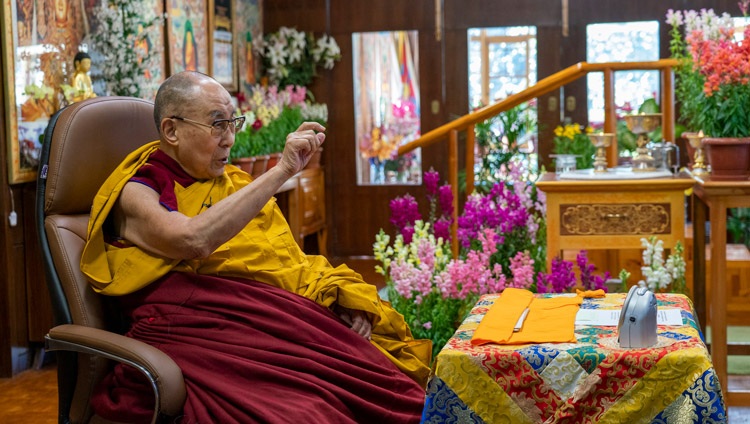
His Holiness considers these three verses to be very powerful. He repeats them to himself and reflects on their meaning regularly. When it comes to reflecting on the nature of self, another verse he relies on can be found in Nagarjuna’s ‘Fundamental Wisdom of the Middle Way’.
Neither the aggregates, nor different from the aggregates,
The aggregates are not (dependent) on him, nor is he (dependent) on the aggregates.
The Tathagata does not possess the aggregates.
What else is the Tathagata? 22.1
His Holiness remarked that he often reworks this to refer to himself and reflects on it accordingly:
I am neither one with the aggregates, nor different from the aggregates,
The aggregates are not (dependent) on me, nor am I (dependent) on the aggregates.
I don’t possess the aggregates.
What else am I?
“When you try to pinpoint who you are in this way and fail to find anything that is the self, you can conclude that the self is a mere designation. Emptiness is the mere negation of an absolute self.”
His Holiness touched on the importance, in developing an understanding of the Middle Way view, of listening to a qualified teacher and reflecting again and again on what they have said. He referred in addition to the primary Indian texts that deal with Madhyamaka: Nagarjuna’s ‘Fundamental Wisdom of the Middle Way’, Chandrakirti’s ‘Entering into the Middle Way’, its auto-commentary and ‘Clear Words’, as well as Aryadeva’s ‘Four Hundred Verses’.
“In Jé Tsongkhapa’s ‘In Praise of Dependent Arising’,” His Holiness continued, “he says, ‘Becoming ordained into the way of the Buddha, by not being lax in study of his words and by yoga practice of great resolve, this monk devotes himself to that great purveyor of truth.’ I feel I too am like this. I received novice ordination before the Jowo Statue in Lhasa and later received the Bhikshu ordination from my preceptor, Ling Rinpoché.
“I have studied the perfection of wisdom and Jé Rinpoché’s texts on the Middle Way: ‘Ocean of Reasoning’ — an extensive commentary on Nagarjuna’s ‘Fundamental Wisdom’; ‘Elucidation of the Thought’ — an extensive commentary on ‘Entering into the Middle Way’; the Special Insight Section of the ‘Great Treatise on the Stages of the Path’; the Special Insight Section of the ‘Medium Length Treatise on the Stages of the Path’ and ‘Essence of Eloquence’ — a treatise differentiating the provisional and definite meanings of the scriptures.
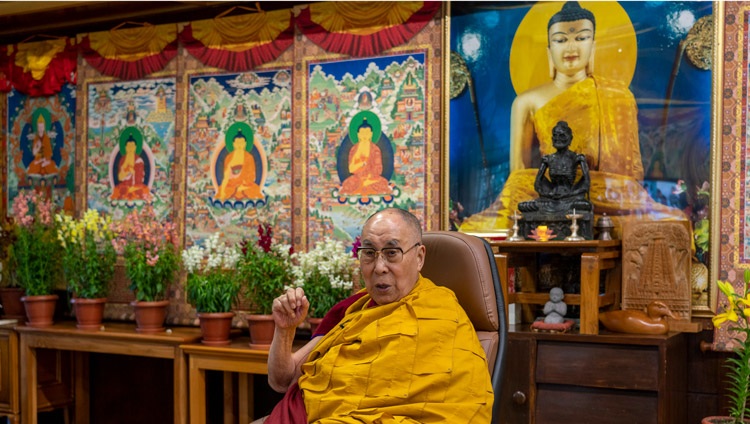
“Therefore, I hope I may be able to achieve some experience of true cessation. As far as the Middle Way view is concerned, I’ve received explanations of it that I have understood, reflected on and familiarized myself with even in dreams. I may not have achieved a complete experience in meditation, but I’ve gained some experience. Texts like this ‘Recognizing My Mother’ remind us of that view. Another work that I’ve found helpful is Panchen Lobsang Chögyan’s ‘Debate Between Wisdom and the Reifying Habit’.
“I received explanations of this text from my Tutor, Ling Rinpoché and from Geshé Tenpa Tenzin of Drepung Monastery.”
His Holiness read briskly through the verses adding comments here and there. He noted that mother here refers to emptiness. Since things do not exist in the way ignorance misconceives them, here is an opportunity for us to understand reality. Duality occurs because of our clinging to the misconception of true existence. Father, here, refers to the object to be investigated.
His Holiness noted that verse eight includes an expression of humility and that in verse nine Manjushrigarbha refers to Tsongkhapa. Kyörpön Rinpoché declared that if you study Tsongkhapa’s five treatises on the Middle Way, you will not be overwhelmed by suffering. His Holiness clarified that we need to find emptiness within ourselves. Some scholars caught up in terminology seem to negate a creature with horns while leaving the object with an everyday appearance of solidity intact.
Other scholars suggest that things must have some existence otherwise it would not be possible to speak of valid cognition and its object. However, what is clear is that things exist, but not in the way they appear to do. His Holiness cited Jé Rinpoché’s observation in the ‘Three Principles of the Path’ that ‘Appearances refute the extreme of existence, emptiness refutes the extreme of nonexistence.’
Verse 13 mentions the Buddhist schools of thought from the Vaibhashikas up to the Svatantrika Madhyamakas who are unable to posit dependent arising precisely. The following verses refer to the ways different Tibetan Buddhist traditions refer to the union of clarity and awareness with emptiness, not only according to the Sutrayana explanation, but also in terms of the clear light mind that the tantras explain. This manifests after the dissolution of the three visions and is the mind employed to realize emptiness. The different terms the various traditions use all refer to the subtlest mind of clear light.
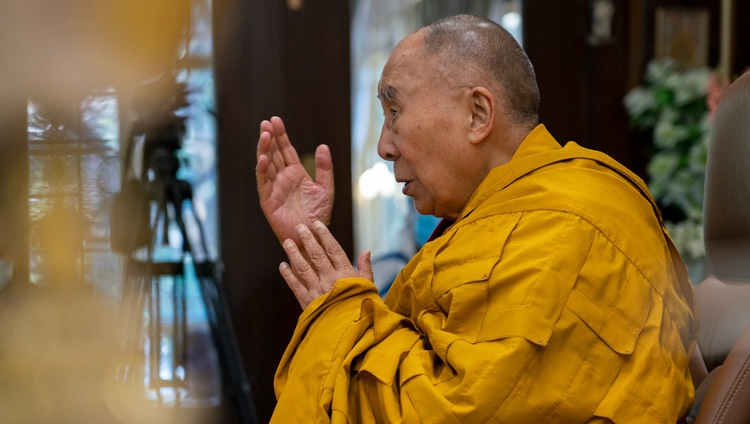
His Holiness read the Song’s remaining verses and declared that he had given the teaching that he had received from Ling Rinpoché. In his notes he had verses from Panchen Lobsang Chögyan’s ‘Debate Between Ignorance and Wisdom’ and he proceeded to read the following verses from it.
When you have a sense of ‘I’ by observing the aggregates
And you can ascertain through valid cognition that this ‘I’
Is not truly established as it appears to be,
Although that is how it does appear to you,
Then you can undermine [the misconception of true existence], which otherwise you can’t.
When you observe the aggregates and think, “I am…”,
And you have a non-affirming negative — the mere negation
Of a truly established [‘I’] — as the apprehended object [of the cognition of selflessness],
Without losing the force of [this awareness] and maintaining it with intense clarity,
You are free of mental laxity and excitement, then you destroy the objective existence of that ‘I’.
When you have observed the aggregates,
And you have an experience, “I don’t exist!”
You become skilled in sustaining this perception of the view.
It counters the sense of a [fixated concrete] ‘I’.
You can push away the [false sense of] an ‘I’.
Yet, [those who can do that] are as rare as the stars during the daytime.
Next, he observed that since it is almost Losar, the Tibetan New Year, he had decided to take the opportunity to conduct a ceremony for generating the awakening mind of bodhichitta. He offered New Year greetings to Tibetans wherever they are, to Ladakhis and to Mongolians. He counseled his listeners to check their minds and examine what they have achieved in the year just gone in relation to study, reflection and meditation. He advised them to make a resolution to do their best in the coming year.
He remarked that he is able to see online and on television how Tibetans in Tibet remain strongly devoted to Avalokiteshvara. He is also aware that the faith they have in him brings them peace of mind. Again, he offered them Tashi Delek for Losar.
“Today, even scientists have developed respect for the traditions we have kept alive,” he told them. “You in Tibet and we in exile must continue to preserve our language, culture and religion. In our schools in exile our students also learn about the mind and how to use reason. Our re-established monasteries have trained thousands of Geshés. Some of you may find yourselves under Chinese rule, but you can reflect that the knowledge we have preserved is something we can share with the Chinese people. This is what I wanted to say to you for Losar.”
His Holiness then began the ceremony to generate bodhichitta, recalling what Shantideva had to say about its remarkable qualities.
For those who fail to exchange their own happiness for the suffering of others, Buddhahood is certainly impossible – how could there even be happiness in cyclic existence? 8/131
Proceeding in this way from happiness to happiness, what thinking person would despair, after mounting the carriage, the Awakening Mind, which carries away all weariness and effort? 7/30
He concluded by reiterating that this was his Losar gift, especially for Tibetans in Tibet, whose spirit remains undaunted.
In answering questions from members of the audience around the world, His Holiness clarified that one of his commitments is to bring peace to the world and within that to encourage inter-religious harmony. Some people believe that everyone is the creation of a God, who they regard as full of love. However, the main message of all religions, he said, is to help others. Even within Buddhist tradition there are proponents of different philosophical points of view, but the main message is not to do harm, but help others wherever you can.
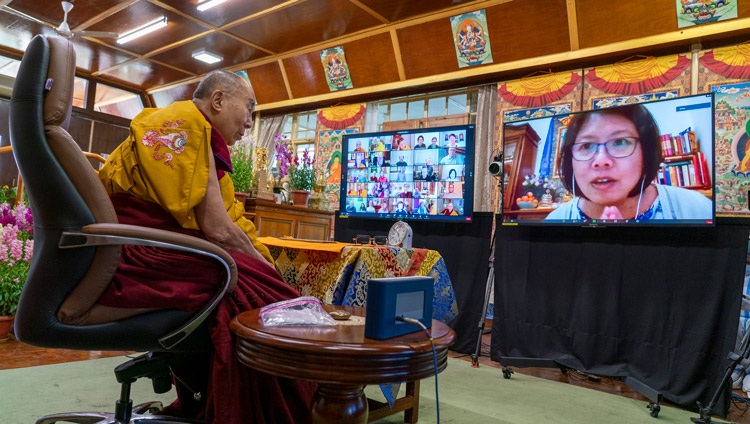
He advised that it is important for those who are very sick or dying to be in a peaceful rather than an agitated state of mind. Therefore, those caring for them would do well to keep them calm. If the ailing person has faith, it’s good to remind them of it.
His Holiness expressed sympathy for those who are unable to have the kind of social interactions that they are used to because of the Covid pandemic. He suggested that social restrictions offer an opportunity to read and study, pointing out that spiritual practitioners conduct their practice in solitude.
Asked how to reconcile sudden enlightenment with a more gradual approach, His Holiness explained that practitioners of Mahamudra and Dzogchen do not focus on external objects so much as on the emptiness of their own minds. Dzogchen refers to ‘rigpa’, pristine awareness and the practitioner seeks to maintain that awareness untouched by misconceptions of intrinsic existence. The luminous nature of the mind, the clarity and awareness of the mind and the clear light mind that manifests after the dissolution of the three visions all deal with the emptiness of the mind.
The ‘Lamp for the Five Stages’ states that following the dissolution of the constituents the clear light mind manifests. Discursive thoughts are withdrawn. The eighty conceptions and the wind energies are withdrawn. All conceptions dissolve. This is the same in all traditions: Geluk, Sakya, Nyingma and Kagyu.
His Holiness told another questioner that we have a sense of self because we speak of my body, my speech, but if we ask ourselves where is the ‘I’ these faculties belong to, we understand that the ‘I’ is a mere designation. It doesn’t exist in the way it appears. It’s not that if doesn’t exist at all, it doesn’t exist intrinsically, from its own side.
His Holiness acknowledged the polarization that can be seen in many places and attributed it to the habit of seeing others in terms of ‘us’ and ‘them’. Young children don’t draw such distinctions. They only learn to recognize differences among their companions when they go to school. He emphasized that everyone is equal in wanting to be happy and to avoid suffering. He pointed out that since the global economy knows no boundaries and since the climate crisis affects us all, we have to take the whole of humanity into account. He expressed his admiration for the spirit of the European Union, whose members have decided to work for the good of the whole union and put past enmities behind them.
Clarifying that an understanding of subtle impermanence, the recognition that things change from moment to moment, helps counter the sense we may have of a permanent self, His Holiness stated that it was not a sufficient basis for realizing emptiness.
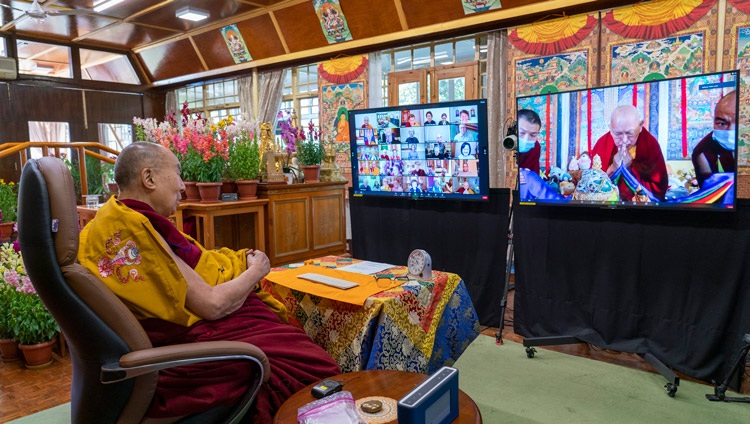
Zopa Rinpoché, speaking in Tibetan, expressed his gratitude to His Holiness on behalf of the FPMT for his teaching today and over many years. He made a formal dedication and offered a mandala.
In response, His Holiness declared, “Zopa Rinpoché and I have known each other a long time. We are trusted friends. You and your teacher Lama Thubten Yeshe founded many centres around the world to help others. Rinpoché, you have done your best, thank you. Please be determined to keep up your efforts. What you have achieved cannot be overlooked. Thank you and Tashi Delek.”

